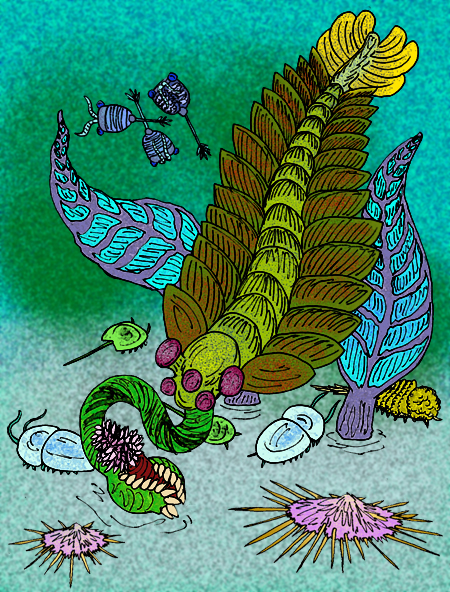Opabinia regalis - Wiki Opabinia
From Wikipedia, the free encyclopedia
[Photo] My reconstruction of the enigmatic Cambrian beast, Opabinia regalis trying to eat an Ottoia priapulid. With the cnidarian Thaumaptilon walcotti, and the arthropods Sarotrocercus oblita, Burgessia bella, Naraoia compacta, Habelia optata, and the sponge and Choia carteri. Author: http://en.wikipedia.org/wiki/User:Apokryltaros
Fossil range: Middle Cambrian
Opabinia is a fossil animal found in Cambrian fossil deposits. Its sole species, Opabinia regalis, is known from the Middle Cambrian Burgess Shale of British Columbia. Myoscolex, from the Lower Cambrian Emu Bay shale of South Australia, is a possible relative. The discoverer of Opabinia, Charles Doolittle Walcott, named it after a local mountain, Opabin Peak in the Canadian Rockies. It is known from fewer than twenty good specimens.
The animal was segmented and had an unmineralized exoskeleton. Total body length ranged from 40 to 70 millimeters. The head carried five stalked eyes that would have given their owner a range of vision of almost 360°, and a long, flexible, hose-like proboscis. At the end of the proboscis were grasping spines; these are theorised to have served as a grab to catch prey, which would then be brought to the mouth, which was located underneath the head, behind the base of the proboscis.
The body segments each featured a set of gills and a pair of flap-like appendages that are also dissimilar to other known animals of the time, save Anomalocaris. The three rearmost flaps formed the tail. Unlike known arthropods, the head does not appear to be formed from fused segments.
Opabinia is thought to have lived on top of the soft sediment on the seabed, although it presumably could have swum after prey using its side flaps. On the bottom, the proboscis could have plunged into burrows after worms. It could also have been used to rapidly stir up sea floor sediment in search of food. If this were the case, Opabinia would then have folded back the proboscis to bring the food to its mouth on the underside of its head.
History of classification
The unusual morphology of Opabinia led to several attempts at classification in the last 100 years. For example, Walcott, the original describer, considered it to be an anostracan crustacean, whilst Leif Størmer, following earlier work by Percy Raymond, thought that it belonged to the so-called "trilobitoids". However, modern studies of Opabinia were initiated by the comprehensive redescription by Harry Blackmore Whittington in 1975, who showed that the frontal structure was a flexible, probably fluid-filled nozzle. Whittington could find no evidence for arthropodan jointed limbs, despite dissecting through the body of the animal to where they would be expected to be found.
The lack of limbs, the annulated but not articulated body, and the unusual lateral lobes with gills led Whittington to conclude that Opabinia was no arthropod. Although he left its classification above the family level open, he considered that it may have been a representative of the ancestral stock from which both the annelids and arthropods arose. The demonsration that Opabinia, and other taxa such as Marrella and Yohoia, cannot be accommodated in modern groups was one of the primary reasons that Stephen J. Gould in his book on the Burgess Shale Wonderful Life, considered that Cambrian life was much more diverse and "experimental" than the extant fauna.
At the time that Whittington's redescription of Opabinia was published, the animal appeared unique. However, a decade later in 1985, Derek Briggs and Whittington published a description of Anomalocaris, also from the Burgess Shale. The Swedish palaeontologist Jan Bergstr??m soon suggested that the two animals were related, based on their shared lateral flaps with gills, stalked eyes and other features. In 1996, Graham Budd suggested that Opabinia was in fact a lobopod, and that it fell within the stem group of the Euarthropoda, along with the anomalocaridids. The details of Budd's reconstruction have recently been criticised by Zhang and Briggs, although they retain Budd's original placement of Opabinia and Anomalocaris in the euarthopod stem group. The morphology of Opabinia thus remains controversial in several details.
The resemblance of Opabinia to some of the so-called "great appendage" arthropods such as Yohoia has led some workers either to place these arthropods at the top of the euarthropod stem group, or to return Opabinia to the euarthropod crown group, in the stem group of the chelicerates. Thus, despite general agreement that Opabinia belongs within the total group of the arthropods, its exact placement remains disupted.
http://en.wikipedia.org/wiki/Opabinia
| The text in this page is based on the copyrighted Wikipedia article shown in above URL. It is used under the GNU Free Documentation License. You may redistribute it, verbatim or modified, providing that you comply with the terms of the GFDL. |
